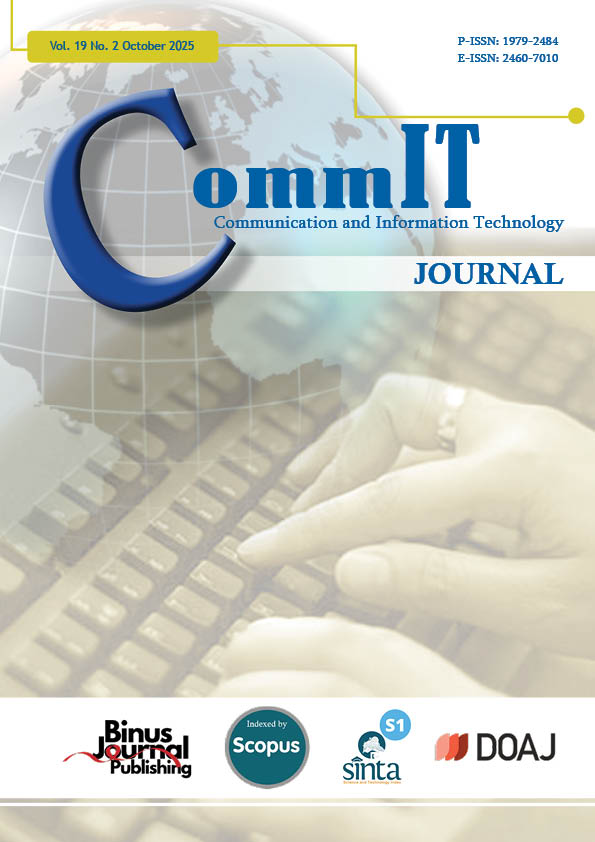Understanding POS ABC Adoption in Indonesia: A Quantitative Analysis Using Modified UTAUT
DOI:
https://doi.org/10.21512/commit.v19i2.13258Keywords:
Point of Sale (POS), Unified Theory of Acceptance and Use of Technology (UTAUT), Micro, Small, and Medium Enterprises (MSMEs), Technology AdoptionAbstract
Micro, Small, and Medium Enterprises (MSMEs) are vital to Indonesia’s economy. However, they face challenges in technology adoption, particularly Point of Sale (POS) systems, which remains relatively low despite their potential benefits. The research addresses the significant gap between the projected and actual adoption of POS ABC, a leading cloud-based POS system in Indonesia, by identifying key determinants that may act as barriers or enablers in the adoption process. By analyzing these factors, the researchers offer theoretical explanations for the suboptimal adoption rate and suggests strategic directions for increasing technology uptake among MSMEs. Utilizing a modified Unified Theory of Acceptance and Use of Technology (UTAUT) framework, the research uniquely integrates system quality as an additional construct to address recurring technical complaints highlighted in user reviews, offering a novel perspective on technology adoption in this context. A quantitative approach is employed, collecting data from 400 MSMEs across Indonesia via online surveys. Structural Equation Modeling (SEM) with SmartPLS 4.1.0.9 is used for analysis, yielding an R² of 49.4% for behavioral intention and 52.5% for use behavior. The findings reveal that performance expectancy, social influence, and habit significantly impact behavioral intention, while facilitating conditions, habit, system quality, and behavioral intention significantly influence use behavior. Effort expectancy, facilitating conditions, and price value show no significant effect on behavioral intention. The findings offer essential insights for developers of POS systems and policymakers, guiding strategies to enhance the adoption of digital solutions and address technical challenges faced by Indonesian MSMEs.
References
[1] H. Limanseto, “Menko Airlangga: Potensi UMKM menjadi modal dalam ekosistem pengembangan ekonomi,” 2023. [Online]. Available: http://bit.ly/45fOVBA
[2] K. Widjajanti, F. N. Prihantini, and R. Wijayanti, “Sustainable development of business with canvas business model approach: Empirical study on MSMEs Batik Blora, Indonesia.” International Journal of Sustainable Development & Planning, vol. 17, no. 3, 2022.
[3] T. Suryani, R. R. Iramani, and Lindiawati, “Exploring financial capability of SMEs and improving financial management performance using financial application,” International Journal of Management and Applied Science (IJMAS), vol. 3, no. 2, pp. 79–83, 2017.
[4] A. Teja, “Indonesian fintech business: New innovations or foster and collaborate in business ecosystems?” The Asian Journal of Technology Management, vol. 10, no. 1, pp. 10–18, 2017.
[5] O. Ogunsuyi and S. O. Tejumade, “Point of sale terminal services and the performance of small and medium-sized enterprises in Nigeria,” International Journal of Social and Management Studies, vol. 2, no. 4, pp. 114–122, 2021.
[6] Y. W. Prihatiningtias and M. R. Wardhani, “Understanding the effect of sustained use of cloudbased point of sales on SMEs performance during COVID-19 pandemic,” The Indonesian Accounting Review, vol. 11, no. 1, pp. 33–46, 2021.
[7] N. A. Prasetyo, A. R. Bahtiar, A. Febriani, and W. A. Saputra, “Adoption of POS technology in MSMEs: A case study of Ecoprint Forum, Purbalingga,” Jurnal Karya Abdi Masyarakat, vol. 7, no. 1, pp. 19–28, 2023.
[8] T. Shabrina and Sfenrianto, “Factors affecting the acceptance of using StoreHub and Majoo: A comparative study between Malaysia and Indonesia,” Journal of System and Management Sciences, vol. 13, no. 3, pp. 16–28, 2023.
[9] D. A. Nurcholisha and J. Lucyanda, “Determinants of the Moka POS adoption by micro, small, and medium enterprises in Jakarta using Unified Theory of Acceptance and Use of Technology model,” Journal of International Conference Proceedings, vol. 5, no. 3, pp. 150–159, 2022.
[10] K. Sai, “An analysis of point of sale systems physical configurations and security measures in Zimbabwean SMEs,” IRA International Journal of Education and Multidisciplinary Studies, vol. 6, no. 2, pp. 181–190, 2017.
[11] A. Handoko and T. Mauritsius, “Factors determining the use of POS (Point of Sales) systems in small and medium sized enterprises,” Turkish Journal of Computer and Mathematics Education, vol. 12, no. 6, pp. 4800–4806, 2021.
[12] V. Venkatesh, M. G. Morris, G. B. Davis, and F. D. Davis, “User acceptance of information technology: Toward a unified view,” MIS Quarterly, vol. 27, no. 3, pp. 425–478, 2003.
[13] V. Venkatesh, J. Y. L. Thong, and X. Xu, “Consumer acceptance and use of information technology: Extending the Unified Theory of Acceptance and Use of Technology,” MIS Quarterly, vol. 36, no. 1, pp. 157–178, 2012.
[14] P. Patil, K. Tamilmani, N. P. Rana, and V. Raghavan, “Understanding consumer adoption of mobile payment in India: Extending Meta-UTAUT model with personal innovativeness, anxiety, trust, and grievance redressal,” International Journal of Information Management, vol. 54, 2020.
[15] C. M. Chao, “Factors determining the behavioral intention to use mobile learning: An application and extension of the UTAUT model,” Frontiers in Psychology, vol. 10, pp. 1–14, 2019.
[16] A. Mujalli, T. Khan, and A. Almgrashi, “University accounting students and faculty members using the Blackboard platform during COVID-19; proposed modification of the UTAUT model and an empirical study,” Sustainability, vol. 14, no. 4, pp. 1–18, 2022.
[17] A. A. Alalwan, “Mobile food ordering apps: An empirical study of the factors affecting customer e-satisfaction and continued intention to reuse,” International Journal of Information Management, vol. 50, pp. 28–44, 2020.
[18] A. M. Baabdullah, A. A. Alalwan, N. P. Rana, H. Kizgin, and P. Patil, “Consumer use of mobile banking (m-banking) in Saudi Arabia: Towards an integrated model,” International Journal of Information Management, vol. 44, pp. 38–52, 2019.
[19] J. P. G. Gashami, Y. Chang, J. J. Rho, and M. C. Park, “Privacy concerns and benefits in SaaS adoption by individual users: A trade-off approach,” Information Development, vol. 32, no. 4, pp. 837–852, 2016.
[20] M. Limayem, S. G. Hirt, and C. M. K. Cheung, “How habit limits the predictive power of intention: The case of information systems continuance,” MIS Quarterly, vol. 31, no. 4, pp. 705–737, 2007.
[21] S. S. Kim and N. K. Malhotra, “A longitudinal model of continued IS use: An integrative view of four mechanisms underlying postadoption phenomena,” Management Science, vol. 51, no. 5, pp. 741–755, 2005.
[22] W. H. DeLone and E. R. McLean, “The DeLone and McLean model of information systems success: A ten-year update,” Journal of Management Information Systems, vol. 19, no. 4, pp. 9–30, 2003.
[23] M. Alshehri, S. Drew, T. Alhussain, and R. Alghamdi, “The effects of website quality on adoption of e-government service: An empirical study applying UTAUT model using SEM,” in 23rd Australasian Conference on Information Systems, Geelong, Dec. 3–5, 2012.
[24] Z. Zhang, T. Cao, J. Shu, and H. Liu, “Identifying key factors affecting college students’ adoption of the e-learning system in mandatory blended learning environments,” Interactive Learning Environments, vol. 30, no. 8, pp. 1388–1401, 2022.
[25] A. Purwanto and Y. Sudargini, “Partial Least Squares Structural Squation Modeling (PLSSEM) analysis for social and management research: A literature review,” Journal of Industrial Engineering & Management Research, vol. 2, no. 4, pp. 114–123, 2021.
[26] J. F. Hair, W. C. Black, B. J. Babin, and R. E. Anderson, Multivariate data analysis. Cengage, 2019.
[27] M. Stone, “Cross-validatory choice and assessment of statistical predictions,” Journal of the royal statistical society: Series B (Methodological), vol. 36, no. 2, pp. 111–133, 1974.
[28] J. Cohen, Statistical power analysis for the behavioral sciences. Lawrence Erlbaum Associates, 1988.
[29] F. M. Abubakar and H. Ahmad, “Adoption of point of sales technology in Nigerian retail industry: A partial least squares approach,” in Proceedings of the International Conference on Industrial Engineering and Operations Management. Riyadh, Saudi Arabia: IEOM Society International, Nov. 26–28, 2019.
[30] M. Merhi, K. Hone, and A. Tarhini, “A crosscultural study of the intention to use mobile banking between Lebanese and British consumers: Extending UTAUT2 with security, privacy and trust,” Technology in Society, vol. 59, pp. 1–12, 2019.
[31] I. K. Mensah, G. Zeng, and D. S. Mwakapesa, “The behavioral intention to adopt mobile health services: The moderating impact of mobile selfefficacy,” Frontiers in Public Health, vol. 10, pp. 1–14, 2022.
[32] Z. Barua and A. Barua, “Acceptance and usage of mHealth technologies amid COVID-19 pandemic in a developing country: The UTAUT combined with situational constraint and health consciousness,” Journal of Enabling Technologies, vol. 15, no. 1, pp. 1–22, 2021.
[33] Indrawati and F. Amalia, “The used of modified UTAUT 2 model to analyze the continuance intention of travel mobile application,” in 2019 7th International Conference on Information and Communication Technology (ICoICT). Kuala Lumpur, Malaysia: IEEE, July 24–26, 2019, pp. 1–6.
Downloads
Published
How to Cite
Issue
Section
License
Copyright (c) 2025 Devia Velicia Eliezer, Sfenrianto

This work is licensed under a Creative Commons Attribution-ShareAlike 4.0 International License.
Authors who publish with this journal agree to the following terms:
a. Authors retain copyright and grant the journal right of first publication with the work simultaneously licensed under a Creative Commons Attribution License - Share Alike that allows others to share the work with an acknowledgment of the work's authorship and initial publication in this journal.
b. Authors are able to enter into separate, additional contractual arrangements for the non-exclusive distribution of the journal's published version of the work (e.g., post it to an institutional repository or publish it in a book), with an acknowledgment of its initial publication in this journal.
c. Authors are permitted and encouraged to post their work online (e.g., in institutional repositories or on their website) prior to and during the submission process, as it can lead to productive exchanges, as well as earlier and greater citation of published work.
Â
USER RIGHTS
All articles published Open Access will be immediately and permanently free for everyone to read and download. We are continuously working with our author communities to select the best choice of license options, currently being defined for this journal as follows: Creative Commons Attribution-Share Alike (CC BY-SA)




















